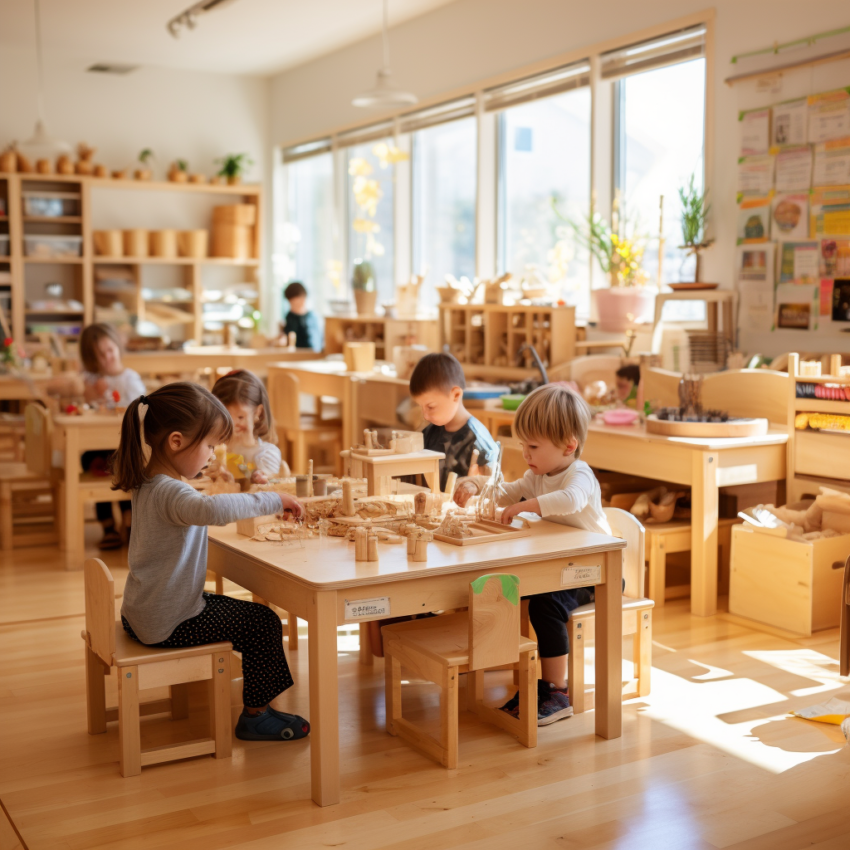Montessori education centers learning around purposeful environments engineered to nurture human development during sensitive cognitive windows spanning birth through adolescence. Properly calibrated spaces and sequenced materials reveal children capable directing their own mastery when adults transform authoritative roles into observant guidance.
“The environment itself will teach the child, if every error he makes is manifest to him, without the intervention of a parent or teacher, who should remain a quiet observer of all that happens.” – Dr. Maria Montessori
But what exactly constitutes a “prepared environment” in authentic Montessori contexts? How might parents and teachers thoughtfully curate spaces uplifting children with minimal intervention yet ever thoughtful intention per Montessori principles?
In Part 1 we will examine the history and research underscoring why environment proves essential unlocking human potential from early childhood especially.
In Part 2 we will offer practical suggestions designing intentional learning spaces whether full classrooms or home corners that optimize student outcomes applying key Montessori environmental elements such as order, beauty and accessibility nurturing children through peaceful productivity.
The Power of Place – Why Environment Shapes Child Development
“The environment must be rich in motives which lend interest to activity and invite the child to conduct his own experiences.”
Dr. Montessori made this profound declaration upholding environmental influence as the invisible educator perpetually shaping young minds, whether deliberately cultivated or occurring haphazardly by default.
A century of research across domains like social psychology, ecological systems theory and spatial cognition now upholdsvibrant correlations between thoughtfully engineered spaces and positive human behavioral outcomes thanks to key environmental dimensions:
Safety & Belonging
- Objects conveying nurture and refuge signal community belonging for shared responsibilities ahead.
Order & Accessibility
- Children crave order organizing complex information. Clear floorplans enable independence.
Beauty & Inspiration
- Aesthetics seed imagination and metaphors making abstract concepts tangible through sensory appeal.
Nature Immersion
- Natural elements soothe minds, revive focus and connect biophilia instincts neglected by urbanization.
Such spatial qualities prove foundational for peaceful guidance, empowered development and collaborative enterprise – precisely the platform Montessori learning communities establish through meticulous environmental engineering decade over decade.
Applied across nurseries, classrooms or even office spaces, Montessori environmental principles unconsciously anchor optimal functioning through alignment supporting bodies and tasks enfranchising students.
Key Montessori Classroom Elements & Attributes
“Children are human beings to whom respect is due, superior to us by reason of their innocence and of the greater possibilities of their future.”
This core dignity principle grounds all Montessori learning spaces seeking to uplift children through deliberate surroundings calming, captivating and coordinating young minds during sensitive cognitive windows. Classrooms incorporate specific spatial ordering, materials arrangements and decorative elements upholding physical, emotional and intellectual harmony.
Furnishings Anchored in solid wood, child-sized tables and shelving establish sturdy independent work spaces minus wobbling frustration over misfitted conventional school desks. Chairs range in shapes facilitating postural mobility. Open carpeted areas allow relocation supporting fluid concentration.
Sensory Integration Natural pine shelves, woven baskets plus living indoor plants offer textured richness grounding focus. Gentle lighting remains ample for vision needs without glare. Sounds flow from water features and musical mobiles drove by children themselves when desired.
Display Intention Meticulous horizontal shelving categorizes learning materials sequentially from left to right mirroring reading flow. Rotated objects convey mindfulness – nothing chaotic. Walls showcase exemplar student work driving engagement not distraction. Beauty calms and inspires.
Nature Immersion Classrooms brim with greenery, crystals, shells and fabric swatches showcasing natural science. Monthly decorative themes feature nature photography, botany plus global culture spotlights widening observational exploration beyond cinder blocks.
Peace Education Calm down cushioned spaces integrate activities like ringing singing bowls, brushed chimes and gratitude journals children utilize independently restoring equanimity that grounds logic and creative flow absent authoritarian rule. Conflict resolution toolkits equip communication and emotional self-regulation skills.
Order & Accessibility Consistent layouts, daily schedules plus tidy storage enable independence navigating classroom environments smoothly. Students own maintaining belongings, clearing work spaces and preparing owned riches freely accessible on shelves welcoming self-directed advancement.
Such intentional environments both externally showcase and internally instill mindfulness, empowerment plus capability amplified by teachers skillfully observing then responding to ever changing student needs from the backdrop instead of dominating direction through instruction alone. This shift to facilitative spatial engineering unleashes student brilliance otherwise restrained.
Creating Mini Montessori Environments at Home
While formal Montessori schools provide ideal ecosystems for children to thrive within thanks to extensive teacher training, those unable to access private academies need not lose out entirely extrapolating aspects home through deliberate environmental design nurturing young minds.
Leverage the core spatial attributes balancing safety, beauty and order to uplift development anywhere kids learn – whether living rooms or bedroom nooks:
Sensory Enrichment Showcase natural objects highlighting distinction and diversity. Display rotating nature art. Add living plants. Incorporate gentle chimes and textured pillows stimulating young senses.
Independence Tracking Anchor low shelves displaying choices accessible physically and mentally appropriate by age like books, puzzles plus stimulation stations children refresh themselves continuing skill-building coordination.
Peaceful Productivity Establish tidy organized children’s spaces like designated playrooms conveying intentional ownership over learning environments and activities while maintaining order through demonstrated responsibilities towards caretaking, maintenance and ongoing contributions to family living spaces smooth functioning.
Guided Freedom Grant open exploration periods for unstructured play imagination using loose parts like blocks, fabric swatches and empty containers purposefully facilitating freedom within thoughtfully bound clear perimeters, soft rules and choices easing transitions redirecting activities on own terms minimizing conflicts needing coercive adult discipline alone.
In applying such Montessori environmental for Montessori at home tenets even partially by injecting living room or bedroom corners with deliberate organization, developmental appropriateness and unconditional trust in children governing use of accessible enrichment materials set before them, tremendous joyful productivity and sense of purpose blooms even home settings parents witness firsthand daily simply by steady exposure alone!

